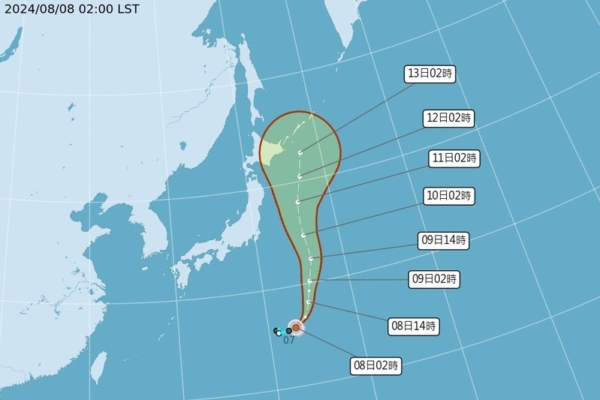Taiwanese meteorologists pointed out today (8th) that a tropical low pressure has developed into a mild typhoon named Maria, which is not a threat to Taiwan and is moving towards the eastern waters of Japan.
Associate Professor Wu Derong of the Department of Atmospheric Sciences at National Central University in Taiwan mentioned in a weather forecast program that the latest model simulations show that the tropical disturbance in the eastern waters of Taiwan is not developing and is expected to move eastward away from the island.
In the early morning at 2 a.m., the Central Weather Bureau’s “Path Potential Forecast Map” indicated that another tropical low pressure has developed into a mild typhoon Maria, moving northeast before turning north, passing through the eastern waters of Japan, and posing no threat to Taiwan. The pattern of the larger low pressure system remains, with more disturbances developing within it. Model simulations are ongoing and require continued observation.
The Central Weather Bureau in Taiwan issued a typhoon advisory today, stating that at 8 a.m. in the Pacific region, a mild typhoon named Maria (international name MARIA) was located at 26.6 degrees north latitude and 144.0 degrees east longitude, moving at a speed of 26 kilometers per hour towards the north-northeast. The central pressure is 995 hPa, with a maximum wind speed near the center of 18 meters per second and gusts of up to 25 meters per second. The average radius of gale-force winds is 80 kilometers (70 kilometers on the northwest and southeast sides, and 110 kilometers on the northeast and southwest sides).
Wu Derong stated that according to the latest European model simulations at 8 p.m. on the 7th, today and tomorrow will see a slight decrease in the highest temperatures, still tending to be hot. In the early morning, there will be convergence of southwest winds and land breezes, with occasional brief showers in the central and southern regions. The tropical disturbance moving eastward after lingering will bring increased moisture to Taiwan, raising atmospheric instability. Strong convection will develop in the afternoon, extending to mountainous areas and some lowlands, leading to heavy thunderstorms. People should be cautious of lightning, strong winds, and heavy rainfall. Temperature ranges for today are 24 to 35 degrees Celsius in the north, 25 to 35 degrees Celsius in the central region, 25 to 35 degrees Celsius in the south, and 23 to 35 degrees Celsius in the east.
Wu Derong indicated that the latest model simulations show that on the 10th and 11th, it will be sunny and hot, with temperatures rising above 37 degrees Celsius. Sun protection and precautions against heatstroke are essential. In the early morning, southwest winds and land breezes will converge, with occasional brief showers in the southwest. The atmosphere remains unstable, with the range of strong convection shrinking slightly in the afternoon, affecting some mountainous areas and lowlands where localized thunderstorms are still likely to occur. Temperatures will slightly drop from the 12th to the 14th. With increased moisture in Taiwan, atmospheric instability will rise, expanding the range of strong convection in the afternoon, leading to heavy thunderstorms. Precautions against lightning, strong winds, and sudden heavy rainfall are advised.
The Central Weather Bureau in Taiwan issued a high-temperature alert, stating that the weather is hot today. Around noon, Taipei City, New Taipei City, Pingtung County, and Hualien County are under a yellow warning signal. People should reduce outdoor activities and labor, avoid vigorous exercise, use sunscreen, stay hydrated, and guard against heat injuries. Keep indoor spaces ventilated and cool, and employ methods to lower body or environmental temperatures, such as fanning or using ice packs. Care should be taken to check on the elderly, children, patients with chronic illnesses, obese individuals, those on medication, vulnerable groups, outdoor workers, or athletes, to minimize prolonged exposure to high temperatures.

